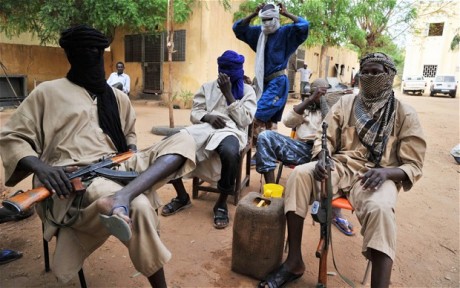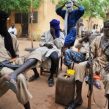
Directions in North African Jihadism in the Post-Mali Conflict Environment
Publication: Terrorism Monitor Volume: 11 Issue: 11
By:

Operation Serval, the French-led military intervention in Northern Mali brought major changes to the strategic landscape and geopolitical trends in the region, curbing, or at least slowing, the increasing presence and local control that jihadist groups have pursued in the region since 2003. The intervention impeded the southward advance of these groups, pushing them back to their strongholds in the desert and beyond. In this sense, the French-led intervention was extremely successful in meeting its limited strategic aims of restricting the activities of the jihadi groups and driving them from their strongholds in northern Mali. Given the situation on the ground, complete elimination of the militants was unlikely, though their power and influence could be significantly diminished.
What follows is an assessment of the re-organization and changes in AQIM and the other regional jihadist groups in the post-Malian conflict environment with reference to the three major geopolitical and strategic levels that will redefine the operational existence of these organizations.
The Local Dimension
Al Qaeda in the Islamic Maghreb (AQIM) and its local jihadist allies (such as Ansar al-Din, the Movement for Unity and Jihad in West Africa [MUJWA] and Mokhtar Belmokhtar’s al-Muwaqi’un bi’l-Dima [Those Who Sign in Blood]) exploited the structural situation of weak statehood, political connivance with incumbent elites and rising instability to establish themselves in the region over the past ten years. Eventually they tried to exploit the local instability by imposing Shari’a and creating an Islamist state in the area historically known as Azawad (northern Mali). However, as shown by the substantial disagreement expressed by the Algerian leadership of AQIM regarding the haste of the project and the way it was implemented, building a Shari’a-based state in northern Mali was hardly considered a strategic priority or even a success for AQIM. [1] If viewed historically, the primary focus of AQIM and its predecessors, the Groupe Islamique Armée (GIA) and the Groupe Salafiste pour la Prédication et le Combat (GSPC) was, and is, Algeria. Northern Mali remains simply a geographical platform for training and organization, a major source of income and a region of jihadist socialization with non-Algerian fighters, but nothing more. AQIM’s greater involvement in the Sahelian strip was largely the result of setbacks the movement suffered in Algeria, especially in the north of the country. Although creating an Islamist state would have provided a major asset in advancing its deeper Algeria-centered agenda of destabilization, it was actually more of a means than an aim in itself.
An internal reorganization of men, priorities and operational structure will likely be a major element in the future configuration of the group. Indeed, one of the most notable events concerning the internal structure of the group was the death of AQIM commander Abd al-Hamid Abu Zeid (a.k.a. Muhammad Ghadir) (Mali Web, March 23; Le Figaro, March 24; see also Terrorism Monitor Brief, March 8). Abu Zeid was one of the key elements in the operational and geographical shift characterizing AQIM over the past five years. More firmly embedded in the Sahelian environment than in the historical strongholds of Algerian terrorism, Abu Zeid’s personal history as a smuggler turned terrorist and the increasing power and freedom of action he enjoyed were essential in what can be described as the Sahelization of the movement, in which the operational primacy of the Sahel over northern Algeria was established and smuggling and other illegal activities took priority over jihad activities. Abu Zeid’s death and replacement by Djamel Okacha will likely bring some major changes to the organization.
Okacha can be considered part of a new generation of jihadists: born in the late 1970s, he was a child during the 1980s when many Algerian militants left the country to join the international anti-Soviet jihad in Afghanistan. Although still very young, he was jailed in 1995 for about 18 months by Algerian authorities and his presence in the Algerian jihadist panorama emerged most visibly at the time of the 1998 GSPC split from the GIA (Afrik.com, March 25; Jeune Afrique, April 9). He is considered to be extremely close to formal AQIM leader Abd al-Malik Droukdel and believed to be much more focused on pure jihad—with some tactical flexibility—than on making money from illegal activities (Le Courrier d’Algérie, March 26).
It is likely that Okacha’s presence in the south is a signal of the Kabylie leadership’s desire to regain greater influence on the strategic orientation of the organization and rebuild the organization’s power structure. As seen during the Islamist occupation of northern Mali, AQIM’s Sahelian commanders substantially ignored the suggestions of Droukdel, whose primary aim was to avoid an external military intervention, knowing this would destabilize AQIM and make it more difficult to ultimately achieve the long-term goals of the organization. In this context, it is likely that one of the tasks awaiting Okacha will be the establishment of more meaningful and functional contacts with Mokhtar Belmokhtar and his splinter group, al-Mua’qi’oon Biddam. Although Belmokhtar was announced dead by the Chadian military, he apparently escaped to southern Libya, resurfacing to claim responsibility for the January 16 – 19 In Amenas attack in Algeria and the May 23 suicide attacks in Niger (Ansar1.info, January 16; Journal du Tchad, March 5, Jeune Afrique, April 16; Tchad Online, May 25).
Although of great impact from a symbolic and strategic point of view, these actions do not seem to serve the more long-term interests of AQIM, since they generally provoke a major reaction from the regional governments and their external supporters. The threat posed by Belmokhtar’s brigade can be exploited by local leaders to ask for more effective financial and strategic support from outside sources.
The Regional Dimension
The Sahel and the Mediterranean Africa region are characterized by the presence of several social and political cleavages that were further strained by the events of the Arab Spring. In Mediterranean Africa, Libya is under severe pressure, owing to the inability of the government to regain control over the militias, the increasing deterioration of security conditions in the east and south and the permeability of its borders. Tunisia is likewise suffering from an increasingly polarized domestic environment. Moreover, the uncertainty characterizing Algeria as it faces a complex path toward the next presidential elections (complicated by the thorny issue of President Abdelaziz Bouteflika’s health) and the persistent fragility of the states belonging to the Sahelian strip make the North Africa region a place where political contradictions and internal rivalries promise years of insecurity.
On a regional basis, the military intervention in Mali and the current political volatility in the region have two major consequences:
· Firstly, the war in northern Mali caused a regional dispersion of the militant groups, but most importantly, it has totally disrupted the trafficking of drugs, weapons and migrants in the region, smashing all the networks transiting through this area and pushing traffickers to finds new routes. AQIM and all the other regional jihadist groups are actively involved in this trafficking and, as such, their movement is also changing according to the redefinition of the smuggling net. This bears some strategic consequences, as it will increase further the vulnerability of some Sahelian and Maghrebi states—Libya, Niger and Mauritania climbing to the top of this list—since regional narco-jihadists will likely move to these countries to carry out their mix of smuggling and jihad.
· Secondly, the political situation in some countries—such as Tunisia, but also Libya—offers some opportunities for AQIM to increase their ideological influence on those Salafist groups that do not belong to the Qaedist world but share some features and aims. That is the case in Tunisia, where AQIM is trying to build deeper and more meaningful relations with Ansar al-Shari’a, though the group remains ideologically distant from AQIM (El Watan [Algiers], May 5). Having established bases along the Algerian border, AQIM has openly threatened Tunisia’s ruling Islamist party, Ennahda, in various messages sent after Ennahda’s decision to ban the more radical Ansar al-Shari’s from holding its annual conference in the city of Kairouan (Al-Sharq al-Awsat, May 20). The overall instability and volatility characterizing the Tunisian transition could push Tunisian Salafists and members of AQIM to promote relations between the two movements, representing a major challenge for the smoothness of the Tunisian political transition and the wider stability of the region.
The Global Dimension
On a more global level, the re-branding of the Algerian militants under the al-Qaeda banner in 2006 partially changed the ideological nature of the group and increased its focus on international and “far enemies,” even though its principal target remained the Algerian state. For AQIM, the far enemy par excellence remained France, the former colonial power, with the movement’s historically-based resentment of France only strengthened by the military intervention in Mali. As such, a video featuring senior AQIM member Abu Obeida Yusuf al-Annabi calling on Muslims to attack French interests worldwide came as no surprise (Le Nouvel Observateur, May 7).
France has suffered from terrorist attacks on its soil related to developments in North Africa, with the Metro bombings of 1995 being the most famous of these attacks. However, what is the nature of the current threat? While the GIA and the GSPC seemed to have some sort of operational networks active on European soil, especially in France, AQIM seems to lack this kind of strategic depth in Europe.
Geographically, AQIM’s focus is in consolidating positions and promoting operations in the Sahel, while Europe is seen mainly as the final market for products smuggled through North Africa. As such, sophisticated, large-scale attacks in Europe that require a robust organizational, operational and strategic capacity seem to be largely unlikely at this stage, although they cannot be entirely excluded. Instead, home-made terrorist attacks carried out by “lone wolves” and homegrown terrorists could represent the most serious concern for France in the wake of AQIM’s threats. Recent trends show how serious these threats have become; the Toulouse attacks in France, the Boston bombing, the Woolwich murder and the recent attack on a Paris policeman all fit this category. This type of threat is particularly elusive since it does not even require an organized sleeper cell; it simply needs a radicalized individual willing to respond to the call of the group and act.
Conclusion
The French-led intervention in Mali changed the strategic environment of the region. For AQIM and other jihadist groups operating in the area, the intervention had several consequences: they had to move elsewhere, reducing their presence in northern Mali, redefine smuggling routes and re-acquire the mobility they partially lost when they started controlling northern Mali. This makes the regional threat more mobile, liquid and fragmented while reducing its actual political impact. Moreover, the overall volatility in the region opens some maneuvering space for regional groups to initiate operational relations with other organizations. In the case of AQIM, greater attention will be paid on reorganizing its Sahelian units, making them more responsive to the Algerian leadership. Re-balancing the operational profile between armed jihad and smuggling will also be a priority, although smuggling remains fundamental to financing the organization and fostering relationships with local criminal groups. The appointment of Droukdel’s man, Djamel Okacha, as Abu Zeid’s successor signals the willingness of the group to make its leadership structure more stable and effective. The appointment of Okacha, an Algerian, also shows that the chain of power in AQIM remains firmly Algerian despite the increased geographical focus on the Sahel.
Dario Cristiani is a PhD Candidate in Middle East and Mediterranean Studies at King’s College London. Previously, he has been a teaching fellow in Political Science and Comparative Politics at the University of Naples "L’Orientale" and a political analyst with the Power and Interest News Report (PINR).
Note
1. Associated Press, Mali-Al-Qaida’s Sahara Playbook,
https://hosted.ap.org/specials/interactives/_international/_pdfs/al-qaida-manifesto.pdf





